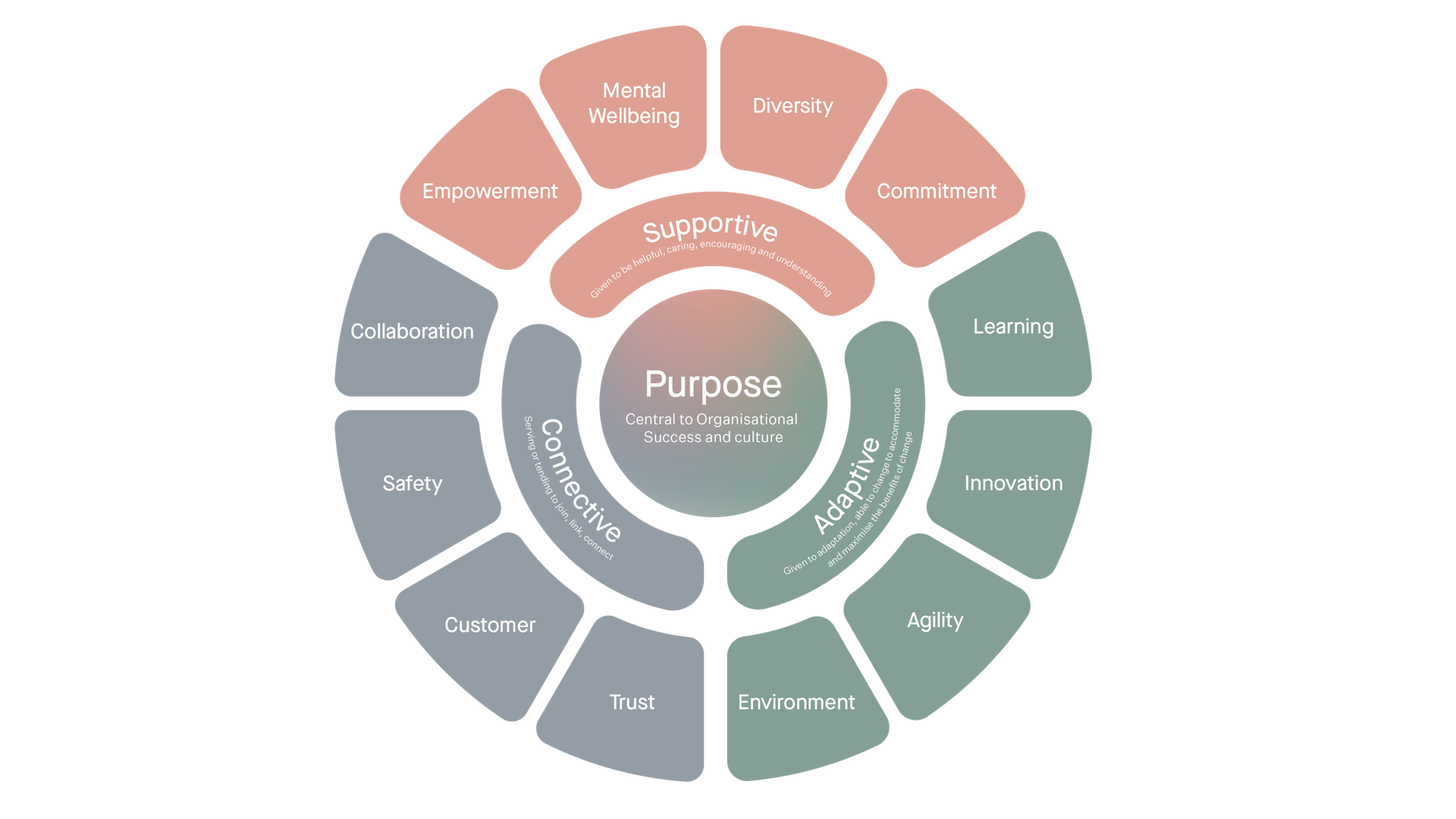Why measuring culture, rather than engagement, is key to long-term business success
As part of our initial discussions with organisations, we inevitably get to discussing company culture. It’s usually at this point that they confirm their commitment to culture, citing their regular employee engagement survey and culture action planning activities, informed by their engagement surveys.
While we applaud the fact that senior leaders are interested in measuring how their employees feel about working for their organisation, these organisations are not measuring culture.
Although culture and engagement are connected, they are not the same and measuring employee engagement versus culture may not provide the sustained success that companies strive for.
Engagement versus culture – why they are different
Culture is directly linked to delivery of your strategy, employee engagement is not
To understand the difference between culture and engagement, one needs to first explore the role of culture in business strategy. Most folks would be familiar with the term “Culture eats strategy for breakfast”. We argue that they are equally important and deserve continuous and conscious effort.
Having a great company culture without a strategy, means lots of good vibes but they are unlikely to last without the prospect of achieving business success. Conversely, a well-crafted strategy without an aligned culture is unlikely to achieve company goals. Why? Because company culture is all about the collective patterns of behaviour that are required to successfully execute the business strategy.
For more on business strategy execution, see How to Execute Your Business Strategy Successfully.
Once an organisation is clear about its purpose, core values, vision and strategic plan, it can then go about articulating the behaviours that are required to deliver the strategy. These collective behaviours will describe how employees are expected to communicate, make decisions and work together to produce business outcomes. And this is precisely what culture is.
So, to get the right culture to deliver long term financial success, you need to ensure that your culture aligns with your business strategy. Then, use a culture measure to determine whether your employees and especially your leaders, are consistently demonstrating the behaviours that will help execute the strategy.
Engagement on the other hand, is about how each employee experiences the overall environment. Sure, if you have high levels of engagement chances are delivering the strategy will be an easier job. But it’s not guaranteed.
Engagement surveys will not tell you whether employees are demonstrating the behaviours that are fundamental to delivering the strategy. This is not to say that measuring engagement is not important. It just doesn’t measure culture. Successful organisations understand and focus on both.
“I” versus “We”
While culture is about the patterns of behaviours that influence how work gets done in organisations, engagement is how employees personally experience working within these patterns, and the level of motivation and commitment they have to the organisation.
Tackling engagement will of course help improve the overall environment and help to motivate employees. However, the actions that you put in place may not get to the root cause of disengagement (culture), and therefore may not be as impactful as you need them to be.
Measuring company culture is about measuring the behaviour the organisation displays as a collective. It provides leaders with actionable insights into the organisational “system”. This will enable leaders to put actions in place that will bring about long-term systemic change.
High engagement does not guarantee a great culture
While a strong culture is likely to lead to high levels of engagement, the converse is not always true. Outstanding engagement results do not ultimately determine a positive or high performing workplace culture.
For more on creating a high performance organisation, see How to Build a High Performance Culture.
Engagement data will reveal how a person feels about their role, their relationships at work, their work life balance and other aspects of the working environment, such as safety. What the data does not tell us is whether these same employees are demonstrating the behaviours that you have articulated to be important to your culture.
Assuming that you have the right culture because your engagement results are high, is a dangerous assumption to make. You may well have a positive culture where people feel good about their day-to-day experience, but it may not be the right culture, one that aligns to your strategy and company goals.
Root cause versus outcome
While it’s already been said that high engagement does not necessarily equate to great culture, more often than not, a positive culture will lead to high levels of engagement. While culture is the root cause, engagement is the outcome.
Because organisational culture is about behaviours which are in turn underpinned by values and beliefs, measuring culture will help organisations truly get to the heart of what is holding them back or propelling them forward. Importantly however, when organisations measure their culture, they gain insight into their DNA, the values and beliefs that are the company’s foundation, and which drive the patterns of behaviours that ultimately determine “how things are done around here”.
Data on your company culture will allow you to explore the deeply held beliefs in the organisation and how these are being demonstrated through behaviours. A robust culture measurement gives organisations the opportunity to make fundamental and systemic change that if done well, will inspire employees and drive business success. Employee engagement data presents organisations with very different insights.
Both culture and engagement are important. If organisations use both to build a strong culture that inspires employees, improves customer satisfaction, and delivers sustainable results, then defining culture first, measuring the baseline and progress as you build the culture will maximise your chances of success. Having engaged employees will naturally follow.
Culture pays
There is no shortage of research that shows that positive cultures drive bottom-line benefits and motivate employees. Positive cultures deliver increased revenue, drive greater shareholder returns, increase innovation, lift job satisfaction and improve retention for employees and clients. A company’s culture, when done well, can offer organisations a unique competitive advantage.
On the flipside, it’s no surprise that toxic cultures can have devastating impacts. An MIT study showed that “a toxic corporate culture was 10 times more predictive of attrition than compensation during the first six months of the Great Resignation”.
Measuring culture – our approach
At Keogh, we felt that while many employee engagement surveys are available, there was a lack of robust tools available that truly measure a company’s culture. So we set about crafting our own. Our investigation began by identifying areas that promote a high performing culture and a flourishing environment for employees.
We drew on our experience, conducted an extensive literature review, sought assistance from subject matter experts and engaged in discussions with clients which led to the development of a culture model that underpins our approach to measuring and shaping culture.
Accompanying this model is a toolbox containing an extensive suite of tools, approaches and processes, including a thoroughly tested survey, that leaders can use to shape and sustain a strong culture.
We call this toolbox, Cultivate, and it is designed for and available to organisations who aspire to build a high-performing culture, where people flourish.
The model identifies 13 different elements that can be found in high-performing, flourishing cultures. Each of these elements is underpinned by a set of behaviours, which form the basis of our survey.
The lead creator of Cultivate, Ian Geddes, talks about how it can help drive business success:
Why use Cultivate?
Designed for today’s changing workplace needs
Cultivate looks at modern workplace culture, so when you use our survey and toolbox, you are provided with a clear picture of what today’s changing working environment needs.
A true measure of organisational culture
While Cultivate shines a light on behaviours that make for a high-performing organisation, where people flourish. These behaviours are backed by more than two years of research and testing.
Boost your change readiness
When you use the Cultivate survey, you will get a quantifiable measure of how ready your organisation is to make the change. This will help to maximise your chances of success.
A toolbox, not just a diagnosis
Cultivate offers you a model, survey, approach and tried and tested tools and processes to build and sustain a positive workplace culture. It offers organisations an end-to-end solution to building a high performance culture that encourages people to shine.
Measurement is just part of the puzzle and successful businesses recognise that following through on what your surveys are telling you is extremely important. Our core offering, aligned to the Keogh Way gives organisations the ability to do exactly this.
It’s a contemporary approach, supported by evidence and deep experience in shifting workplace cultures.
Tailored support for leaders
Leaders have a disproportionate impact on shaping culture. To better understand their cultural impact, our toolbox also includes Cultivate 360, a diagnostic that provides leaders with valuable feedback on their behaviour and how it influences company culture.
How we are using Cultivate
Cultivate was launched in 2022 and interest continues to grow. We have used our Cultivate surveys and toolbox with a wide range of organisations to support an acquisition process, align an organisation’s culture to its refreshed strategy and focus on areas that will improve talent attraction and retention – to name a few of its applications.
Start measuring workplace culture
If you want to get a true measure of your current culture and find out how you can leverage it to get the best out of your people and the organisation, contact us.








